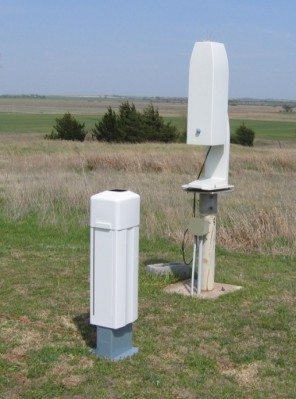Ceilometer Represents First Deployment of New Ground-based Instruments from Recovery Act
Published: 6 May 2010

In April, a new ceilometer was deployed at the ARM Southern Great Plains site’s Central Facility, leading the charge for an influx of more than 100 new ground-based instruments slated for installation throughout the user facility through the
American Recovery and Reinvestment Act.
“We have a large number of instruments procured through the Recovery Act in various stages of development and testing, and a few are already installed and operating on a Learjet aircraft for the SPARTICUS campaign, but this is the first one that is now officially collecting routine ARM data. This is a very exciting time for us!” said Jimmy Voyles, an engineer at Pacific Northwest National Laboratory and the project lead for ARM’s Recovery Act investments.
The ceilometer is designed to measure cloud-base height at up to three levels and potential backscatter signals by aerosols. It works by transmitting near-infrared pulses of light into the sky. The receiver detects the light scattered back by clouds and precipitation.
The ceilometer is one of three instruments – the others being a present weather sensor and sunphotometer – that make up an integrated measurement suite known as the Boundary Layer Cloud System. Victor Morris, a scientist at PNNL, is overseeing the implementation of the system throughout the user facility.
“The combination of these three instruments was not available at each of the sites before the Recovery Act,” said Morris. “Now we’ll be able to provide consistency in the measurements from the ceilometers, sun photometers, and present weather sensors at all the ARM fixed and mobile sites to enhance the study of cloud formation processes and their influence on radiative transfer.”
In use since 1994, the CT25K model installed throughout the user facility was discontinued by the vendor in 2007. The new CL31 provides increased spatial and temporal resolution, improved algorithms for cloud amount and mixing-layer height, and a modular design for easy field servicing. They have been configured to optimize the performance for aerosol and boundary-layer detection. The remaining new ceilometers will be shipped out for deployment at the other ARM sites.
The ARM Climate Research Facility is a DOE Office of Science user facility. The ARM Facility is operated by nine DOE national laboratories, including .
Keep up with the Atmospheric Observer
Updates on ARM news, events, and opportunities delivered to your inbox
ARM User Profile
ARM welcomes users from all institutions and nations. A free ARM user account is needed to access ARM data.


















